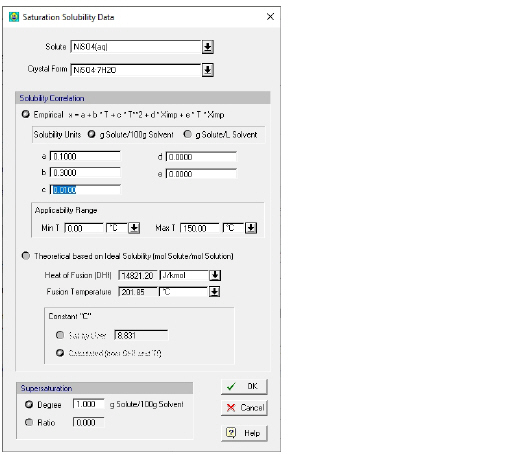

The following table shows a brief description of the variables appearing in this tab. The table also displays their default values and their generally acceptable range
|
Variable |
Default Value |
Range |
|
|
||
|
○ Empirical Solubility Correlation |
|
|
|
○ Theoretical Solubility Correlation |
|
|
|
○ MinT (°C) |
0 |
|
|
○ MaxT (°C) |
150 |
|
|
○ Heat of Fusion (J/kmol) |
0.188 |
Positive |
|
○ Fusion Temperature (°C) |
201.85 |
Positive |
|
◙ Constant C |
0.0 |
Positive |
|
◙ Supersaturation Degree |
0.0 |
Positive |
|
◙ Supersaturation Ratio |
0.0 |
Positive |
Symbol Key: ○ User-specified value (always input); ● Calculated value (always output); ◙ Sometimes input, sometimes output
The following list describes the available specification choices in this tab; for more details on how these are implemented, see Continuous Cooling Crystallization: Modeling Calculations.
•Empirical Solubility Correlation...
The saturation solubility (either in g solute/100 g solvent or g solute/L solvent) is calculated by an empirical correlation of the form:
|
|
eq. (A.302) |
where T is the crystallization temperature and Ximp is the mass-based impurity ratio. Notice that SuperPro considers as impurities the components that have been designated as solutes but are not crystallizable. If the crystallization temperature is below the minimum temperature of the applicability range, there is a chance solubility increases with decreasing temperature. In this case, the solubility is estimated with a linear extrapolation based on two values near the low limit.
•Theoretical Solubility Correlation...
The saturation solubility (in mol Crystal/mol Solution) is calculated by a theoretical Vant-Hoff type equation using the heat of fusion ΔHf and a corresponding reference temperature Tf (melting point). The constant term Cf can either be calculated as Cf = ΔHf/RTf or set by the user
|
|
eq. (A.303) |